OEM Enamel Skillet | China Cast Iron Pan Factory
In the world of culinary tools, few items command as much respect and versatility as the cast iron skillet. But when enhanced with a layer of vitreous enamel, it transforms into a modern kitchen powerhouse. This guide delves deep into the world of the enamel skillet, exploring everything from industry trends and meticulous manufacturing processes to technical specifications and customization options. As a leading enameled cast iron frying pan factory in China, we provide an insider's look into what makes this cookware an essential investment for both home cooks and professional chefs.
Industry Trends: The Resurgence of Durable and Safe Cookware
The global cookware market is witnessing a significant shift. Consumers are increasingly moving away from disposable, coated pans towards durable, long-lasting, and non-toxic alternatives. Market analysis shows a projected growth for the cast iron cookware segment, with a CAGR of over 4.5% from 2023 to 2030. This trend is driven by several factors:
- Health Consciousness: Growing concerns about chemicals like PFOA and PTFE found in some non-stick coatings have pushed consumers towards materials like cast iron and enamel, which are certified safe by bodies like the FDA and LFGB.
- Sustainability: An enamel skillet is a buy-it-for-life product. Its incredible durability reduces waste and the need for frequent replacements, aligning with eco-conscious values.
- Performance Demands: The "foodie" culture, amplified by social media, has raised the bar for home cooking. Amateurs and professionals alike seek tools that deliver superior results, and the exceptional heat retention of an enameled cast iron frying pan meets this demand perfectly.
- Aesthetic Appeal: Modern enameling techniques allow for a vibrant array of colors, turning a functional tool into a beautiful piece of kitchen decor that can go from stove to table.
As a prominent China enameled cast iron frying pan manufacturer, we are at the forefront of this trend, combining timeless craftsmanship with modern technology to meet this growing global demand.

Technical Deep Dive: What Makes an Enamel Skillet Superior?
An enamel skillet is a composite product, brilliantly merging the thermal properties of cast iron with the non-reactive, easy-to-clean surface of porcelain enamel. Understanding its components reveals its technical advantages.
Core Material: High-Grade Cast Iron
The heart of our skillet is cast iron, an alloy of iron and carbon (typically 2-4%). Its key property is high thermal mass, which translates to two critical performance benefits:
- Superior Heat Retention: Once heated, cast iron stays hot. This is crucial for achieving a perfect sear on steaks, as the pan's temperature doesn't plummet when cold food is introduced.
- Even Heat Distribution: It eliminates hot spots, ensuring food cooks uniformly whether it's in the center or at the edges of the pan. This reduces the risk of burning in one area while another is undercooked.
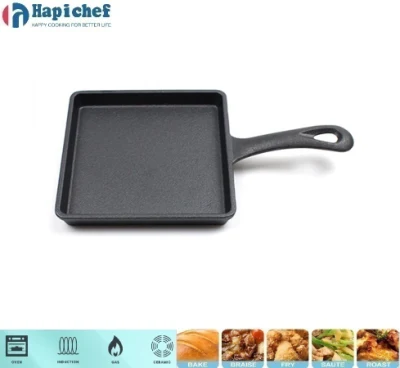
Surface Coating: Vitreous Porcelain Enamel
The enamel is essentially a layer of glass fused to the iron at extremely high temperatures (over 1400°F / 760°C). This creates a bond that is both chemical and physical, resulting in a surface that is:
- Non-Reactive: Unlike bare cast iron, the enamel surface will not react with acidic foods like tomatoes, wine, or citrus. This means no metallic taste is imparted to your food, and the pan's "seasoning" is not stripped away.
- Impermeable and Easy to Clean: The smooth, non-porous surface resists staining and sticking, making cleanup significantly easier than with traditional cast iron. No seasoning is required.
- Corrosion Resistant: The enamel coating protects the underlying cast iron from rust, a common issue with bare cast iron if not meticulously cared for.
Performance Visualization: Heat Retention Comparison
To quantify the advantage of an enamel skillet pan, we can analyze its heat retention capabilities compared to other common materials like aluminum. The chart below illustrates how an enameled cast iron pan maintains its temperature over time after being removed from a heat source.
Fig 1: Heat retention of an enameled cast iron frying pan vs. an aluminum pan over 10 minutes. The cast iron's gradual temperature decline ensures food stays warm longer and provides a more stable cooking surface.
From Raw Iron to Culinary Masterpiece: The Manufacturing Process
Creating a high-quality enamel skillet is a complex, multi-stage process that requires precision, expertise, and stringent quality control. As a leading enameled cast iron frying pan factory, we adhere to the highest international standards, including ISO 9001, to ensure every piece is flawless.
1. Raw Material
Sourcing high-purity pig iron and recycled steel. Strict chemical analysis ensures low levels of impurities.
2. Casting
Melting iron in an induction furnace and pouring it into sand molds created by a high-pressure DISA molding line for precision shapes.
3. Shot Blasting
The raw casting is blasted with tiny steel balls to remove sand and create a textured surface for enamel adhesion.
4. Enameling
Applying two to three layers of enamel frit (ground glass) via electrostatic spraying for uniform coverage. A black matte base coat is followed by colored top coats.
5. Firing
The enameled piece is fired in a kiln at ~800°C (1475°F). This melts the frit and fuses it to the iron, creating a durable, vitreous surface.
6. Quality Control
Rigorous inspection for thickness, adhesion (impact test), and cosmetic defects. Products are tested to meet FDA and LFGB standards.
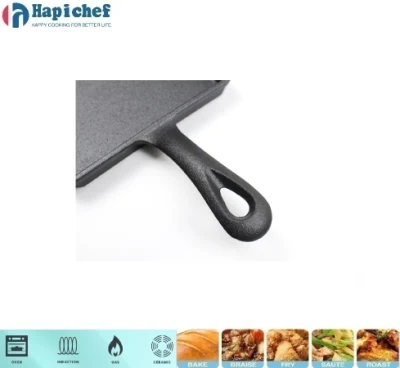
Cookware Comparison: Why Choose an Enamel Skillet?
Choosing the right skillet can be daunting. This table compares the key features of an enamel skillet against its main competitors to help you make an informed decision.
| Feature | Enameled Cast Iron Skillet | Bare Cast Iron Skillet | Stainless Steel Skillet | Non-Stick (PTFE) Skillet |
|---|---|---|---|---|
| Heat Retention | Excellent | Excellent | Good | Poor |
| Non-Reactivity | Excellent | Poor (Reacts with acid) | Excellent | Excellent |
| Maintenance | Easy (No seasoning) | High (Requires seasoning) | Moderate | Moderate (Avoid metal) |
| Max Oven Temp | ~500°F / 260°C | Very High (>600°F) | ~500°F / 260°C | ~400°F / 200°C (Varies) |
| Durability / Lifespan | Decades+ | Generations | Decades+ | 1-5 Years |
| Versatility | Excellent (Sear, braise, bake) | Good (Not for acidic foods) | Good (Sauté, pan sauces) | Limited (Delicate foods) |
Our Premier Product: The HapiChef Cast Iron Enamel Skillet
We proudly present our flagship product, the Cast Iron Cookware Kitchenware Cooking Pot Small Fry Pan Skillet. It embodies the pinnacle of our manufacturing expertise, designed for discerning chefs who demand performance and style.
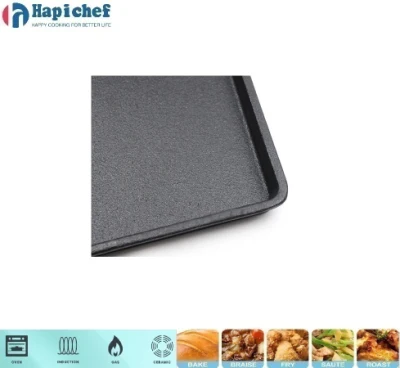
Key Specifications & Features:
- Material: Premium Grade Cast Iron with triple-layer vitreous enamel.
- Compliance: FDA, LFGB, CA Prop 65 certified.
- Interior: Stain-resistant, matte black enamel that promotes caramelization.
- Handles: Ergonomically designed for a secure grip, even with oven mitts.
- Heat Source Compatibility: Gas, Electric, Induction, Ceramic, Halogen, and Oven safe.
- Warranty: Limited Lifetime Warranty against manufacturing defects.
Technical Specification Table
| HapiChef Enamel Skillet Technical Data | |
|---|---|
| Product SKU | HP-SK01 |
| Diameter Options | 8-inch, 10.25-inch, 12-inch |
| Weight (10.25-inch) | Approx. 5.5 lbs (2.5 kg) |
| Material Core | Gray Cast Iron (ASTM A48 Class 25) |
| Enamel Coating Thickness | Interior: 300-500µm | Exterior: 350-600µm |
| Oven Safe Temperature | Up to 500°F (260°C) |
| Dishwasher Safe | Yes (Hand washing recommended for longevity) |
| Certifications | ISO 9001:2015, BSCI, FDA, LFGB |
OEM/ODM Customization: Your Brand, Our Expertise
Beyond our own brand, we are a world-class oem enameled cast iron frying pan partner for global brands. Our state-of-the-art facility and experienced R&D team can bring your vision to life. If you're looking for a reliable China enameled cast iron frying pan supplier, we offer comprehensive customization solutions.
Our OEM/ODM Process:
- Consultation & Design: We work with your team to understand your brand identity, target market, and specific design requirements (shape, size, handle design).
- Mold Development & Prototyping: We create new molds based on your 3D drawings and produce initial samples for your approval.
- Color & Finish Matching: Our enamel lab can match any Pantone color and develop unique finishes (gloss, matte, gradient).
- Branding & Packaging: We can customize the skillet with your logo (embossed on the base or handle) and design retail-ready packaging.
- Mass Production & Quality Assurance: We leverage our efficient production lines and multi-point QC process to deliver high-quality products on schedule.
- Logistics & Support: We offer flexible shipping options and dedicated after-sales support.
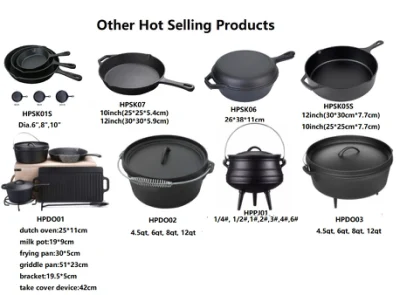
Application Cases: Where Performance Shines
Case Study 1: The Professional Steakhouse
Client: "The Gilded Grill," a high-end steakhouse chain.
Challenge: Needed a pan that could achieve a consistent, deep crust on premium cuts of steak during a fast-paced dinner service and could also be used as a serving vessel.
Solution: They adopted our 12-inch enamel skillet. The pan's superior heat retention meant it stayed searing-hot even after multiple uses. The enamel surface prevented any flavor transfer between different dishes and made cleanup between services faster. The vibrant red exterior also provided a stunning "stove-to-table" presentation.
Result: "The sear is perfect every time. Our chefs love them, and our customers are impressed by the presentation. A true workhorse." - Executive Chef.
Case Study 2: The Artisan Baker
Client: "Rise & Shine Bakery," a local artisan bakery.
Challenge: Wanted a versatile pan for baking skillet cornbread, deep-dish cookies, and savory tarts that provided even baking and an attractive finish.
Solution: Our 10.25-inch enameled cast iron frying pan was the perfect tool. Its even heat distribution ensured golden-brown crusts without burnt bottoms. The non-reactive enamel was ideal for berry-filled tarts, and the easy-release surface meant baked goods came out perfectly intact.
Result: Sales of their skillet-baked goods increased by 30%. The pan's durability has meant zero replacements in over two years of heavy daily use.
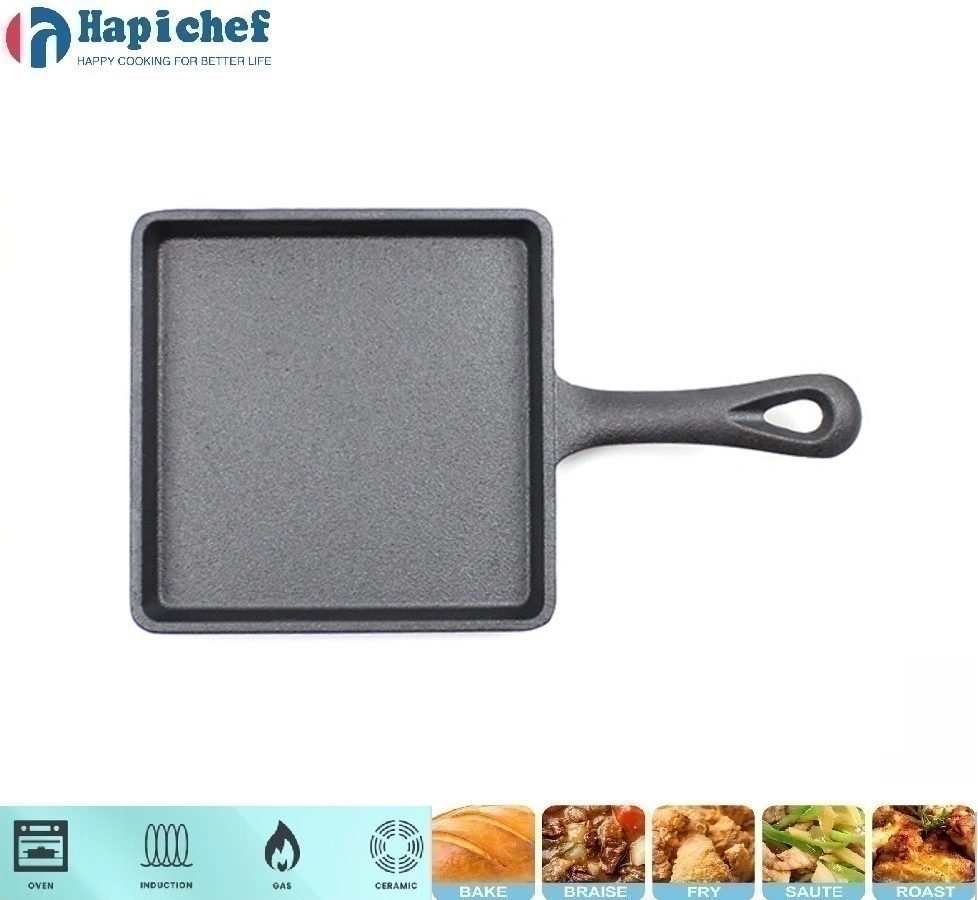
Ready to Elevate Your Cooking or Your Brand?
Experience the unmatched quality and performance of a HapiChef enamel skillet. Whether you are a culinary professional, a passionate home cook, or a brand seeking a reliable manufacturing partner, we have the solution for you.
Explore Our Product & OEM ServicesFrequently Asked Questions (FAQ)
Vitreous enamel (or porcelain enamel) is a material made by fusing powdered glass to a substrate (in this case, cast iron) through firing at very high temperatures. The result is a hard, non-porous, and durable coating. It is completely safe for cooking. Our enamel coatings are inert, non-reactive, and free from lead, cadmium, PFOA, and PTFE. They are rigorously tested to meet strict international food contact standards like FDA (USA) and LFGB (Germany).
Both offer excellent heat retention. The key difference is the surface. A bare cast iron skillet requires "seasoning"—a layer of baked-on oil—to create a non-stick surface. This seasoning can be stripped by acidic foods and requires careful maintenance. An enamel skillet has a pre-applied, non-reactive glass surface. It does not require seasoning, can be used with any type of food, and is much easier to clean and maintain.
We strongly recommend using wood, silicone, or nylon utensils to preserve the beauty and integrity of the enamel finish. While the enamel is very durable, sharp or heavy metal utensils could potentially scratch or chip the surface over time. These superficial scratches (metal marks) can often be cleaned, but deep chips are not repairable.
DISA is a leading manufacturer of high-tech molding equipment. DISA molding is a vertical, flaskless sand molding process that operates at high pressure. This technology allows us, as an enameled cast iron frying pan factory, to produce castings with high dimensional accuracy, a smoother surface finish, and consistent weight. This precision is crucial for ensuring the enamel coating applies evenly and the final product is perfectly balanced.
Both are food-grade safety standards. The FDA (Food and Drug Administration) sets the standards for the United States. LFGB (Lebensmittel-, Bedarfsgegenstände- und Futtermittelgesetzbuch) is the German Food and Feed Code. LFGB testing is often considered more stringent than FDA requirements, involving more comprehensive tests for substance migration. Our products pass both, demonstrating their safety for global markets.
Thermal shock is stress that can cause cracking or damage to materials subjected to a rapid change in temperature. For an enamel skillet, this means you should avoid plunging a hot pan into cold water or placing a cold pan onto a pre-heated high-temperature burner. Always allow your pan to heat up and cool down gradually to ensure its longevity.
Lead times for an oem enameled cast iron frying pan order vary based on complexity and volume. A typical timeline is:
- Mold Development: 30-45 days
- Sample Production & Approval: 15-20 days
- Mass Production: 45-60 days after sample approval and deposit
References & Further Reading
- The Porcelain Enamel Institute. (n.d.). What is Porcelain Enamel? Retrieved from https://www.porcelainenamel.com/
- Kenji López-Alt, J. (2019). The Food Lab: Better Home Cooking Through Science. W. W. Norton & Company. An excellent resource on the physics of cooking with different materials.
- ASTM International. (n.d.). ASTM A48/A48M-03(2016) Standard Specification for Gray Iron Castings. Referenced for material standards. www.astm.org
-
Transform Your Kitchen with Big Iron Cast Wok CraftsmanshipNewsAug.05,2025
-
Traditional Cooking with Cast Iron Woks and Pots with HandlesNewsAug.05,2025
-
Outdoor and Indoor Cooking with Cast Iron Wok MasteryNewsAug.05,2025
-
Maximize Outdoor Cooking Versatility with Premium Cast Iron WoksNewsAug.05,2025
-
Master Traditional Cooking with a Chinese Cast Iron WokNewsAug.05,2025
-
Culinary Power with High-Performance Cast Iron WoksNewsAug.05,2025
-
Why Every Kitchen Needs a Casserole Cast Iron DishNewsJun.24,2025
